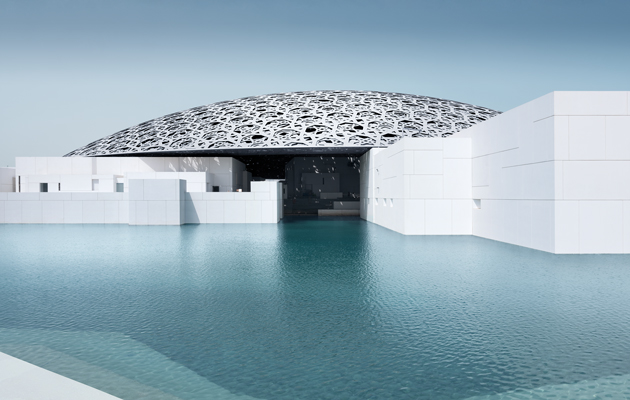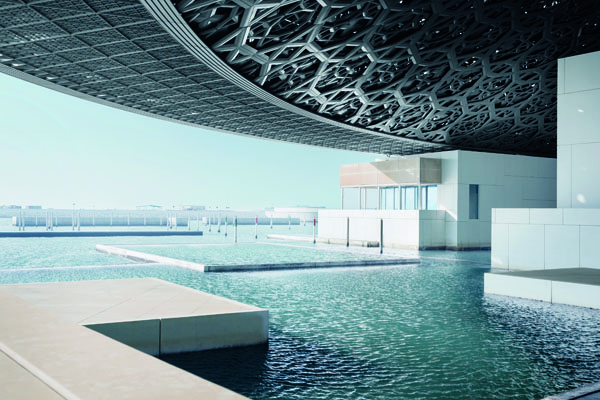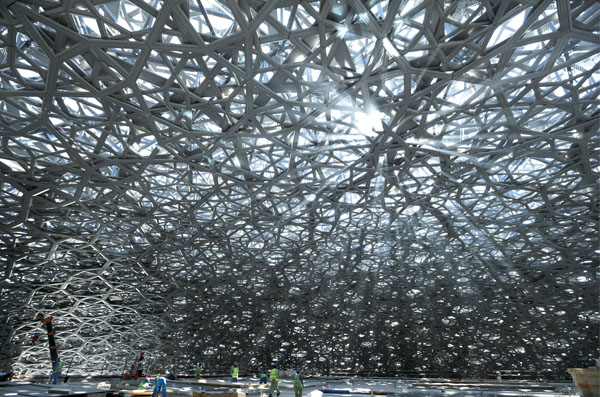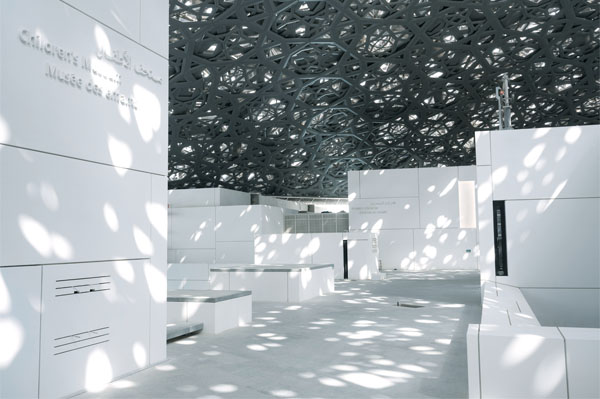Jean Nouvel revels in the architectural possibilities and paradoxes of the Arab world’s first ‘universal museum’

What does it mean to establish a museum today that aspires to universality? Can the ambition of a comprehensive narrative of humankind – with its attendant implication of a forward direction to human progress – can such a fiction be sustained in a post-postmodern era, after the transformative challenges of the recent past to universal truths, coherent identities and the authentically real? In an era in which global trade, mass travel and instant communications both homogenise place and proliferate pluralism? And what does it mean to construct this ambition on a site in an Islamic state in the Persian Gulf, with a history as a modernised urban society of less than a half-century?
The Louvre Abu Dhabi, designed by Ateliers Jean Nouvel, and which finally opens to the public in November after a gestation of more than a decade, is the focus and lens of these ambitions and the crucible of their contradictions. A ‘universal museum’, built by Indian labourers on a watery site in the United Arab Emirates, designed by a French architect who describes himself, perhaps redundantly, as ‘a contextual architect’. This museum, in the words of Jean Nouvel, ‘belongs to the territory, it belongs to the history, it belongs to this climate, and every sign or symbol of this building is linked to the Arabian culture’.
For Nouvel himself, the completion of the Louvre Abu Dhabi marks the end of a 30-year orbit of the architectural legacy of the Arab world that began with his Institut du Monde Arabe of 1987 in Paris. Through its geometric lucidity, ornamental intricacy and its profound relationship to light, this tradition has furnished an enduring touchstone for Nouvel’s architecture. In both projects, a key element of Arabic architecture has been identified, abstracted and suavely transmuted into a powerful emblem of oriental modernity. In the former, it was the carved mashrabiya window screens that in Nouvel’s hands became a mechanical brise soleil of stainless-steel precision and curtain-wall sleekness. In the latter, it has been the great domes – those ornate artificial firmaments of the great Islamic religious buildings – that have provided the key image. Once again, Nouvel has succeeded in effectively refreshing the traditional form for contemporary sensibilities, maintaining the intricate beauty of the original while avoiding kitsch literalism.

Architecturally, the Louvre Abu Dhabi is the conjunction of two ideas of ancient provenance: the dome and the citadel. The drama of the work emerges from the juxtaposition of these complementary principles, further enhanced by the siting of the project at the juncture between land and sea. Each of these components is articulated through geometric and symbolic archetypes. The dome is the celestial sphere: pure, luminous and divine; while the citadel is the worldly domain formed from cubic blocks of varying sizes and proportions: an aggregation of urban elements. The sea gives the project its horizon and gives it buoyancy; while the land links it back to the desert sands that form the Emiratis’ national soil.
The massive overarching dome, shielding the museum from the Arabian sun and splintering it into the coruscating ‘Rain of Light’, is the grand iconic gesture of the project, embracing with its vast sweeping arc the medina of cubic galleries and transforming the complex into a giant arena of culture. This is an epic structural manoeuvre, 180m in diameter, 7m thick, a sandwich of eight layers of overlapping and continuously varying star-shaped aluminium panels laid over a supporting steel truss. The patterning is not uniform – the porosity has been carefully tuned across the surface to vary the shading, resulting in an average reduction of incident light of over 98 per cent. By some auspicious coincidence, at 7,500 tonnes the dome is almost identical in weight to the Eiffel Tower, a fact reported with some pride by Abu Dhabians. Like that tower, the dome is supported at only four points, but the structural piers performing this feat are artfully concealed, giving the impression of an enormous disc hovering above the sea.

Walking across the main public level of the complex, elevated above the shimmering surface of the sea while immersed in a cascade of slivers of light, is indeed an extraordinary experience. The fine dust suspended in the desert air lends mass and grandeur to the shifting shafts of light. The Cyclopean scale of the elements, both the dome and the oversized white concrete panels that interlock to form the cubic galleries, gives the complex a strange quality that is neither archaic nor futuristic but combines aspects of both. What is wholly unexpected is the acoustic quality. Just as in the great domed halls of antiquity, the acoustic reflectivity of the dome lifts and enlivens the auditory environment, bringing clarity and resonance to distant voices and footsteps and heightening the sense of moment and place.
Counterpointed against this is a loose huddle of white cubic volumes of varying proportions – 55 in all – rising out of the water or hanging off the foreshore. These blocks define a range of spaces, including the congregation of linked rooms that make up the core gallery spaces. It is, Nouvel says, ‘not a building but a neighbourhood’. He continues: ‘We have a lot of spaces like in a city, with narrow streets as well as wide. Every gallery of the museum is a building. It is an urbanity – a game with the scale of these little white cubes. The inside is a lot bigger than appears from the little buildings in the medina. Every one is a gallery, and the museography is linked also to a kind of palatial scale and nobleness of the interior spaces.’
Inside, the exhibition spaces unfold in an enfilade of grand rooms of varying proportions, each separated from the next by a threshold space that opens to a glimpse of the sea beyond or the dome above. While the walls are finished in a consistent white, the generic neutrality of the typical ‘white cube’ exhibition space is mitigated by giving the floors of each room a distinct finish in stone sourced from the region, described by Nouvel as a kind of mineral ‘carpet’. Here again, even in such small details, the tension between the universal and the particular is felt.

The Louvre Abu Dhabi is not a satellite outpost of its French namesake but an independent entity with its own curatorial agenda and collection policy. Initiated by an inter-governmental agreement signed in 2007 between Abu Dhabi and France, it describes its mission as the first ‘universal museum’ in the Arab world, explicitly aligning itself with a position outlined in a 2002 declaration by the oldest, richest, and most powerful museums of the West – including the Louvre and the British Museum – of the ‘Importance and Value of Universal Museums’. This argument has been used to defend against the push to repatriate certain artefacts in their collections, which in Britain was most notably in relation to the status of the Elgin Marbles in the British Museum. This issue, and the notion that certain privileged institutions may designate themselves ‘universal’, has been highly controversial, not least as this position has been adopted exclusively by Western institutions.
However, the positioning of the Louvre Abu Dhabi as a new universal museum outside the West complicates this reading.
Jean-François Charnier, the scientific director of the Louvre Abu Dhabi and chief author of its narrative of humanity, suggests that the destination of the story told through the collection is not pre-determined. ‘The aim,’ Charnier says, ‘is to create a universal perspective on things, not from a Western or an Eastern perspective, but from Abu Dhabi’s position as a crossroads.’
Nonetheless, while the museum has been steadily making acquisitions for its own collection, its cultural heft is underwritten by its founding agreement, which incorporates a 30-year loan arrangement with 13 major cultural institutions in France. Apart from the Louvre itself, these include the Centre Pompidou, the Musée d’Orsay, and the Musée du Quai Branly. The true depth of its collection remains firmly in French hands, at least for now.
For Nouvel, the paradox of a specific view of the universal is addressed by the mythic qualities of the project, an echo of which is reflected in Nouvel’s explicitly poetic reading of its ‘cosmography’. ‘The dome is the symbol of the cosmography, which for a long time in architecture has been a symbol of the sky and the universe. The presence of the sky is very important on the original site: Water, Sun and Sky. The cosmography is a symbol also of universality – of the content of the museum, and its choice to talk about meetings. This is a meeting place for objects, for artworks, for the testimony and the witnesses of all these civilisations at different epochs. So to have a symbolic architecture of the universality, of the consciousness of the world, is important to play with.’
Such monumental themes; such a splendid creation! Yet all this is merely part of a far larger developmental agenda by the rulers of Abu Dhabi. The museum is the first of a set of major cultural elements to be delivered of the masterplan of Saadiyat Island, translated as the ‘Island of Happiness’. This is a large chunk of Abu Dhabi east of the older urban centre, wrapped by a thin luxurious veneer of beachfront hotels and villas. Others in this category, which spatial theorist Keller Easterling describes as ‘contagious global spatial products for architourism and culture’, include the Zayed National Museum, designed by Foster + Partners, and the Guggenheim Abu Dhabi, by Frank Gehry, with others by Tadao Ando and the late Zaha Hadid on the roster over the next decade. These cultural icons are complemented by educational institutions, including an imposing outpost of New York University.
The scale of these ambitions and the manner by which they are being implemented reflects the characteristics of the Gulf monarchies’ distinctive recipe for urbanisation and national ‘uplift’. This involves a version of what Easterling calls the ‘zone’, a separate administrative space whose operating system complements and exceeds the state, devoted to the transplantation of foreign species and hybridisation with the national gene pool.
In the case of Saadiyat Island, the zone is an island – a largely artificial one. And the Louvre Abu Dhabi is an island within this island, doubling the remove but perhaps squaring its efficacy. In the era of ‘mondialisation’, perhaps this indeed is the most appropriate geography of a new local model of universalism – in which the unities are shifting archipelagos of affiliation and intersections of trajectories, and in which the ocean becomes the substitute for what was once described as the continental – the privileged, invisible centre (or blind spot?) from which the universals were defined and mapped. The promise of the Louvre Abu Dhabi is that on this small island, in the shadow of a tessellated eclipse of a monotheistic sun, the cosmography of a multitude of universalisms – each local, specific, and unique – may be imperfectly illuminated.
by Julian Worrall
Photography by Mohamed Somji

















